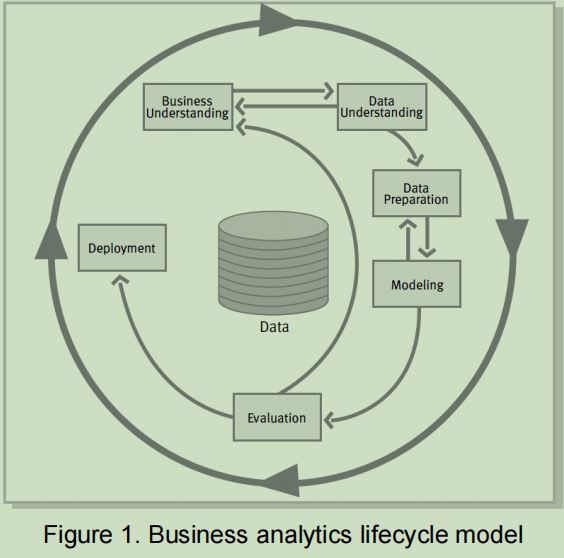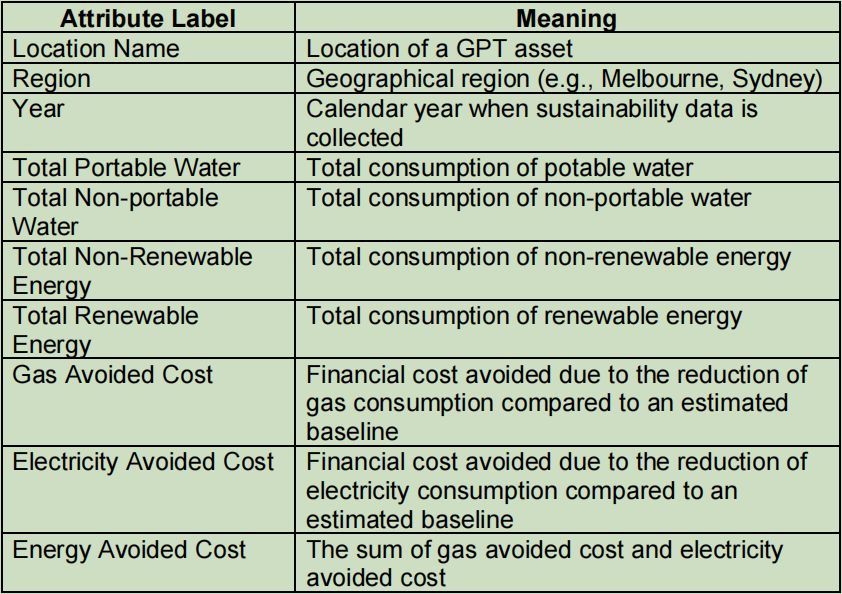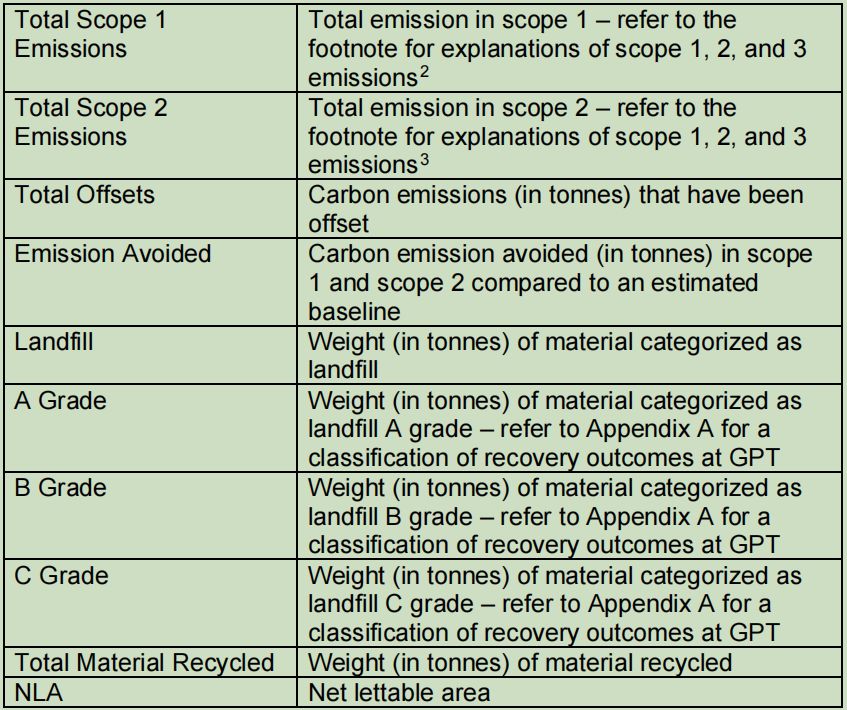INFS5720 Sustainability at GPT: Deriving Insights from Descriptive Analytics Assignment
- Subject Code :
INFS5720
- University :
UNSW, Sydney Exam Question Bank is not sponsored or endorsed by this college or university.
- Country :
Australia
1. An Overview
The objective of this assessment is to test your application of the business analytic Life cycle model, as shown in Figure 1, by using visualization techniques on a real-world data set from the company GPT. The data set from GPT documents its sustainability data at various property assets that the company manages. Please read the following sections of this instruction document and develop a business report based on the tasks specified. Please refer to Appendix B for the marking rubric of this assessment.

2. Key Dates
Task
Submitting an individual report
Naming convention StudentID-StudentName
CourseID
Deadline
3:00pm Friday 23 June
(Week 4)
3. Case Description
GPT (https://gpt.com.au/) is a leading property group in Australia and manages a portfolio of properties including offices, logistics, and retail assets. The company aims to provide high quality real estate spaces that enable people to excel, and customers INFS5720 Individual Assessment:
Descriptive Analytics for Sustainability and communities to prosper in a sustainable way1. GPT ranked first among 800 real estate companies listed in the S&P Global 2022 Annual Corporate Sustainability Assessment. Sustainability is one of the top strategic priorities at GPT. Over the years, the company has made significant achievements in attaining sustainability goals and developing sustainability innovations, which are manifest in various aspects including energy consumption, carbon emission, water consumption, and waste management.
Energy consumption:
GPT commits to reducing its energy consumption and increasing the use of renewable energy. For example, the company developed a smart energy plan to prioritize renewable energy (e.g., on-site solar energy) and innovative technologies (e.g., smart meters) for monitoring energy usage. The energy reduction commitments have directly contributed to the companys carbon neutrality.
Carbon emission:
GPT is the first organization that attain carbon-neutral certification issued by Climate Active across Scope 1, 2, and 3 emissions (for a definition of each emission type, please refer to https://www.sustaim.earth/post/scope-1-2-and-3-emissions). The company has retained the highest GRESB (Global Real Estate Sustainability Benchmark) rating of 5 Stars. The companys decarbonization has greatly benefited from the use of renewable energy (e.g., solar, battery storage).
Water consumption:
GPT also has deliberately reduced its water consumption and strategically managed stormwater. The company has achieved 62% improvement in its water intensity (i.e., net water usage per square metre of the let table area of managed space) since 2005.
GPT proposes a clean up/slow down approach to ensure the quality of the water that flows into the environment. Specifically, clean up includes activities such as minimizing potential pollutants that could enter into stormwater. Slow down includes activities such as reducing the speed of stormwater leaving a building so that it reduces potential damage to the local environment. Based on its experiences in managing energy consumption, the company is moving towards achieving water neutrality.
Waste management:
GPT proposes a close-loop waste management approach with the aim of maximizing A-grade recycling and minimizing materials that end up in the landfill. The company classifies waste into four categories: A-, B-, C- grade, and landfill. A-grade recycling (also refer as close-loop) is about recovering materials without subsequent hazards to the environment. For example, if cardboard is separated and processed properly, it can be recycled into new cardboard. B-grade recycling is about down cycling original materials to less valued materials, with a limited number of recovery cycles. C-grade recycling is about waste materials that can be used for only one additional application.
Over time, GPT has Over 7,000 tonnes of materials being recovered based on closeloop principles. The company also has achieved 3.3 NAMBERS (National Australian Built Environment Rating System) waste rating for its office portfolio.
4. Tasks
Assuming you are a business analyst at GPT. You have been provided with a data set: GPT data-individual assessment-INFS5720 (see data set uploaded to Moodle:Assessments). Each student needs to upload this data set to SAS Viya platform by following the instruction file and video provided on Moodle. Using this data set and SAS Viya platform, you should use data visualization analytics to help the board of directors understand the sustainability performance of GPT, and its financial implications (e.g., cost reduction). Based on your visualization analysis, you also need to identify the opportunities for GPT to improve its sustainability activities in the future.
You shall perform the following tasks:
- Identify specific sustainability issues (e.g., energy consumption, water consumption, etc) that you aim to gain insights;
- Select and justify appropriate variables to analyze the performance of a sustainability issue you identified;
- Apply visualization techniques (e.g., bar chart, histogram, line chart, etc) to describe the sustainability performance;
- Recommend actionable insights for GPT to improve their sustainability performance in the future.
Some generative questions for you to consider:
- What is GPTs sustainability performance such as energy consumption, water consumption, waste management, or carbon emission?
- What are the changes in GPTs sustainability performance over time?
- What are the changes in GPTs sustainability performance across geographical regions?
- What are the factors (e.g., renewable, non-renewable energies) that have contributed to GPTs decarbonization?
- Are there associations between GPTs sustainability performance and its financial performance? If so, how would you explain the associations you discovered?
- Are there changes in GPTs sustainability performance before and after COVID-19? If so, how would you explain the changes?
5. Description of Data Attributes


6. Formulas can be used for data analysis
To obtain more insights into GPTs sustainability performance, please consider using the following formula based on variables provided in the data set.
- Total Energy Use = Total Renewable energy + Total Non-Renewable Energy
- Energy Intensity = [Total Energy use] * 1000 / NLA
- Total Water = [Total Non-Portable Water] + [Total Portable Water]
- Water Intensity = [Total Water] * 1000 / NLA
- Scope 1 Emissions Intensity = [Total Scope 1 emissions]*1000/NLA
- Scope 2 Emissions intensity = [Total Scope 2 emissions]*1000/NLA
- Net Emissions = Scope 1 + Scope 2 Total Offsets
- Energy Avoided Cost = Gas Avoided Cost + Electricity Avoided Cost
7. The Use of Generative AI
As this assessment involves business recommendations for GPTs sustainability activities, you are permitted to use software to generate initial ideas. However, you must develop or edit those ideas to such a significant extent that what is submitted is your own work. Any output of generative software within your assessment must be attributed with full referencing.
To cite: OpenAI (Year Accessed). ChatGPT. OpenAI. https://openai.com/ Please note that the outputs from these tools are not always accurate, appropriate, nor properly referenced. You should ensure that you have moderated and critically evaluated the outputs from generative AI tools such as ChatGPT before submission.
If the outputs of generative AI such as ChatGPT form part of your submission and is not appropriately attributed, it will be regarded as serious academic misconduct and subject to the standard penalties, which may include 00FL, suspension and exclusion.
You need to keep copies of the initial prompts if there is any uncertainty about the originality of your work. The best practice for using generative AI is to apply critical thinking to select and improve the answers suggested by an AI tool. These practices can be demonstrated by the following examples:
- Attach the prompts you used in a generative AI tool as an Appendix of your report;
- Explain the process of how to improve the answer generated by AI by comparing answers based on the same query made to generative AI or modifying incorrect suggestions.
8. Formatting and Deliverables
- UNSW Coversheet. Submit your assignment with a signed cover sheet. Fail to include the UNSW coversheet will lead to a 10% penalty, and no marks will be released until the coversheet is received.
- Length. The total length of the report should be 1200 words with a leeway of 10%, excluding cover sheet, table of contents, tables, and references.Fail to comply with the word limit will lead to a 10% penalty. Please note that essential information should be presented in the main text of your report. Tables or figures are not used to avoid word limitation.
- Table of Content. Should not exceed one page, restricted to two levels of headlines.
- Format. You should use headings, sub-headings, page numbers, bullet points, diagrams, and tables as appropriate. The file format of the report is PDF.
- References. References and citations should follow Harvard Referencing.
- Appendices. All assessment items should be included in the main document. An appendix can be used to present the prompts from generative AI, where applicable.
- File naming: should be StudentID-StudentName-CourseID. Fail to use the correct file naming will lead to a 5% penalty.
9. Academic Honesty and Plagiarism
As a student at UNSW you are expected to display academic integrity in your work and interactions. Where a student breaches the UNSW Student Code with respect to academic integrity, the University may take disciplinary action under the Student Misconduct Procedure. To assure academic integrity, you may be required to demonstrate reasoning, research and the process of constructing work submitted for assessment.
INFS5720 has specific requirements for this industry-collaboration-based assessment. Breaching the items below will result in academic misconduct.
- The use of the GPT data is limited to this assessment ONLY, and is NOT to be used for any other purposes.
- Except for SAS Viya, students are NOT allowed to upload GPT data to any other software platform including generative AI.
- Students are NOT allowed to contact GPT for any questions about the data set and/or this assessment; Any questions about this assessment should be answered by INFS5720 teaching team.
10. Special Consideration
You can apply for special consideration when illness or other circumstances beyond your control interfere with your performance in this assessment task.
Applications can ONLY be made through Online Services in myUNSW (see the UNSW Current Students page). Applications will not be accepted by teaching staff.
The lecturer-in-charge/course coordinator will be automatically notified when your application is processed.
Special consideration applications will be assessed centrally by the Case Review Team, who will update the online application with the outcome and add any relevant comments. The change to the status of the application immediately sends an email to the student and to the assessor with the outcome of the application.
Are you struggling to keep up with the demands of your academic journey? Don't worry, we've got your back! Exam Question Bank is your trusted partner in achieving academic excellence for all kind of technical and non-technical subjects.
Our comprehensive range of academic services is designed to cater to students at every level. Whether you're a high school student, a college undergraduate, or pursuing advanced studies, we have the expertise and resources to support you.
To connect with expert and ask your query click here Exam Question Bank

